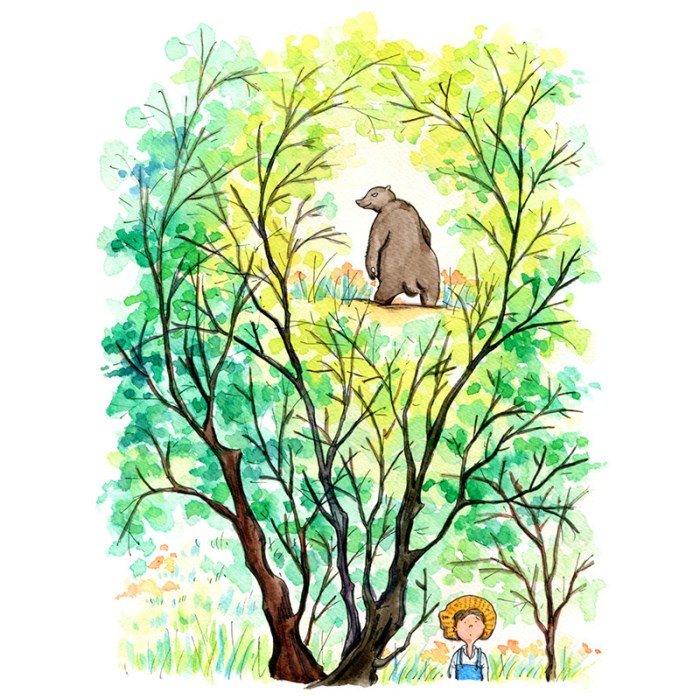The bear william faulkner summary – Unveiling the depths of William Faulkner’s masterpiece, “The Bear,” this comprehensive summary delves into the intricate plot, captivating characters, and profound themes that have captivated readers for generations.
Faulkner’s prose paints a vivid canvas, immersing us in the untamed wilderness of the American South, where the hunt for a legendary bear becomes a poignant exploration of humanity’s relationship with nature, tradition, and the complexities of the human condition.
Plot Summary: The Bear William Faulkner Summary

The novel follows the lives of the McCaslin family in Yoknapatawpha County, Mississippi, over the course of several generations. The story begins with Isaac McCaslin, a young man who is coming to terms with his family’s history of slavery and violence.
As Isaac delves deeper into his family’s past, he uncovers a complex web of relationships and betrayals that have shaped his own life.
The novel’s central conflict revolves around the tension between the McCaslins’ desire for redemption and their inability to escape the legacy of their past. Isaac’s journey is ultimately a search for meaning and purpose in a world that is marked by violence and injustice.
The novel is set in the American South during the 19th and 20th centuries. Faulkner’s vivid descriptions of the landscape and the people who inhabit it create a powerful sense of place that is essential to the novel’s meaning.
Characters
Isaac McCaslin
Isaac McCaslin is the protagonist of the novel. He is a young man who is coming to terms with his family’s history of slavery and violence. Isaac is a complex and sympathetic character who is torn between his desire for redemption and his inability to escape the legacy of his past.
Lucius Quintus Carothers McCaslin
Lucius Quintus Carothers McCaslin is Isaac’s great-grandfather. He is a ruthless and violent man who is responsible for many of the tragedies that befall the McCaslin family. Lucius Quintus is a symbol of the destructive power of slavery and violence.
Samuel Beauchamp
Samuel Beauchamp is a slave who is owned by the McCaslins. He is a proud and independent man who refuses to be broken by the brutality of slavery. Samuel Beauchamp is a symbol of the resilience and strength of the human spirit.
Themes
The Legacy of Slavery
The Bear is a powerful indictment of slavery and its legacy of violence and racism. Faulkner shows how slavery corrupts both the slave owners and the slaves themselves. The novel also explores the complex ways in which the legacy of slavery continues to shape American society.
The Search for Redemption, The bear william faulkner summary
The Bear is also a story about redemption. Isaac McCaslin’s journey is a search for meaning and purpose in a world that is marked by violence and injustice. Isaac’s ultimate goal is to find a way to break free from the cycle of violence that has plagued his family for generations.
The Importance of Nature
Nature plays a central role in The Bear. Faulkner’s descriptions of the landscape are often lyrical and evocative. Nature is a source of both beauty and danger in the novel. It is a place where people can find solace and renewal, but it is also a place where violence and death can occur.
Symbolism and Motifs

The Bear
The bear is a powerful symbol in the novel. It represents both the beauty and the danger of nature. The bear is also a symbol of the wild and untamed part of human nature.
The Hunt
The hunt is a recurring motif in the novel. It is a symbol of the violence and danger that is ever-present in the world. The hunt also represents the search for meaning and purpose.
The River
The river is a symbol of life and renewal. It is also a symbol of the passage of time. The river flows inexorably forward, carrying with it the hopes and dreams of those who live along its banks.
Style and Technique

Narrative Structure
The Bear is a complex and non-linear novel. Faulkner uses multiple narrators and flashbacks to tell the story from different perspectives. This narrative structure allows Faulkner to explore the novel’s themes from multiple angles.
Language and Imagery
Faulkner’s language is rich and evocative. He uses vivid imagery to create a powerful sense of place and atmosphere. Faulkner’s prose is also often lyrical and poetic.
Point of View
Faulkner uses a variety of points of view in The Bear. This allows him to explore the novel’s themes from multiple perspectives. The novel is primarily narrated in the third person, but Faulkner also uses first-person narration in some sections.
Critical Reception and Legacy
The Bear was a critical and commercial success when it was first published in 1942. The novel has been praised for its powerful writing, its complex characters, and its exploration of important themes. The Bear is considered one of Faulkner’s masterpieces and is widely regarded as one of the greatest American novels of the 20th century.
The Bear has had a lasting impact on American literature. The novel has been adapted into several films and television shows. It has also been the subject of numerous critical studies. The Bear continues to be read and studied by students and scholars today.
Key Questions Answered
What is the central conflict in “The Bear”?
The central conflict revolves around the tension between the old ways of life, represented by the wilderness and the bear, and the encroaching forces of modernization and progress.
How does Faulkner use symbolism in the novel?
Faulkner employs extensive symbolism throughout the novel, with the bear representing both the untamed wilderness and the primal instincts within humanity, while the hunt symbolizes the pursuit of meaning and connection.
What is the significance of the setting in “The Bear”?
The novel’s setting in the untamed wilderness of the American South serves as a microcosm of the human experience, reflecting the struggle between civilization and nature, tradition and modernity.

